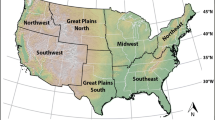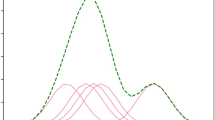Abstract
A simple climate model was designed as a proxy for the real climate system, and a number of prediction models were generated by slightly perturbing the physical parameters of the simple model. A set of long (240 years) historical hindcast predictions were performed with various prediction models, which are used to examine various issues of multi-model ensemble seasonal prediction, such as the best ways of blending multi-models and the selection of models. Based on these results, we suggest a feasible way of maximizing the benefit of using multi models in seasonal prediction. In particular, three types of multi-model ensemble prediction systems, i.e., the simple composite, superensemble, and the composite after statistically correcting individual predictions (corrected composite), are examined and compared to each other. The superensemble has more of an overfitting problem than the others, especially for the case of small training samples and/or weak external forcing, and the corrected composite produces the best prediction skill among the multi-model systems.










Similar content being viewed by others
References
Barnston AG, Mason S, Goddard L, Dewitt DG, Zebiak SE (2003) Multimodel ensembling in seasonal climate forecasting at IRI. Bull Amer Meteor Soc 84:1783–1796
Cehelsky P, Tung KK (1987) Theories of multiple equilibria and weather regimes – A critical reexamination. part II: Baroclinic two-layer models. J Atmos Sci 44:3282–3303
Charney JG, Straus DM (1980) Form-drag instability, multiple equilibria and propagating planetary waves in baroclinic, orographically forced, planetary wave systems. J Atmos Sci 37:1158–1176
Doblas-Reyes F, Déqué M, Piedelievre J-P (2000) Multi-model spread and probabilistic seasonal forecast in PROVOST. Quart J Roy Meteor Soc 126:2069–2087
Feddersen H, Navara A, Ward MN (1999) Reduction of model systematic error by statistical correction for dynamical seasonal prediction. J Climate 12:1974–1989
Graham RJ, Evans ADL, Mylne KR, Harrison MSJ, Robertson KB (2000) An assessment of seasonal predictability using atmospheric general circulation models. Quart J Roy Meteor Soc 126:2211–2240
Kang I-S, Shukla J (2005) Dynamical seasonal predictability and predictability of Monsoon. In: Wang B (ed) The Asian Monsoon. Praxis publishing Ltd., In press
Kang I-S, Lee J-Y, Park C-K (2004) Potential predictability of summer mean precipitation in a dynamical seasonal prediction system with systematic error correction. J Climate 17:834–844
Kharin VV, Zwiers FW (2002) Climate prediction with multi-model ensembles. J Climate 15:793–799
Krishnamurti TN, Kishitawal CM, Zhang Z, Larow T, Bachiochi D, Williford E (2000) Multimodel ensemble forecasts for weather and seasonal climate. J Climate 13:4196–4216
Mo K (2003) Ensemble canonical correlation prediction of surface temperature over the United States. J Climate 16:1665–1683
Palmer TN (1993) Extended-range atmospheric prediction and the Lorenz model. Bull Amer Meteor Soc 74:49–65
Palmer TN (1999) A Nonlinear dynamical perspective on climate prediction. J Climate 12:575–591
Palmer TN, Anderson DLT (1994) The prospect for seasonal forecasting – A review paper. Quart J Roy Meteor Soc 120:755–793
Palmer TN, Brankovic C, Richardson DS (2000) A probability and decision-model analysis of PROVOST seasonal multi-model ensemble integrations. Quart J Roy Meteor Soc 126:2013–2035
Palmer TN, Alessandri A, Andersen U, Cantelaube P, Davey M, Délécluse P, Déqué M, Díez E, Doblas-Reyes FJ, Feddersen H, Graham R, Gualdi S, Guérémy J-F, Hagedorn R, Hoshen M, Keenlyside N, Latif M, Lazar A, Maisonnave E, Marletto V, Morse AP, Orfila B, Rogel P, Terres J-M, Thomson MC (2004) Development of a European multimodel ensemble system for seasonal-to-interannual prediction (DEMETER). Bull Amer Meteor Soc 85:853–872
Pavan V, Doblas-Reyes FJ (2000) Multi-model seasonal hindcasts over the Euro-Atlantic: skill scores and dynamic features. Climate Dyn 16:611–625
Peng P, Kumar A, van den Dool H (2002) Analysis of multimodel ensemble predictions for seasonal climate anomalies. J Geophys Res 107, 4710, doi:10.1029/2002JD002712
Qin J, Robinson WA (1995) The impact of tropical forcing on extratropical predictability in a simple global model. J Atmos Sci 52:3895–3910
Reinhold BB, Pierrehumbert RT (1982) Dynamics of weather regimes: Quasi-stationary waves and blocking. Mon Wea Rev 110:1105–1145
Rowell DP (1998) Assessing potential seasonal predictability with an ensemble of multidecadal GCM simulations. J Climate 11:109–120
Schneider EK, Kinter JL III (1994) An examination of internally generated variability in long climate simulations. Climate Dyn 10:181–204
Shukla J, Anderson J, Baumhefner D, Brankovic C, Chang Y, Kalnay E, Marx L, Palmer T, Paolino D, Ploshay J, Schubert S, Straus DM, Suarez M, Tribbia J (2000) Dynamical seasonal prediction. Bull Amer Meteor Soc 81:2593–2606
Stern W, Miyakoda K (1995) Feasibility of seasonal forecasts inferred from multiple GCM simulations. J Climate 8:1071–1085
Yoo JH, Kang I-S (2005) Theoretical examination of a multi-model composite. Geophys Res Lett, 32, L18707. DOI 10.1029/2005GLO23513
Yun WT, Stefanova L, Krishnamurti TN (2003) Improvement of the multimodel superensemble technique for seasonal. J Climate 16:3834–3840
Zheng X, Sugi M, Frederiksen CS (2004) Interannual variability and predictability in an ensemble of climate simulations with the MRI-JMA AGCM. J Meteor Soc Japan 82:1–18
Acknowledgements
The present study was supported by the Climate Environment System Research Center sponsored by the Korean Science and Engineering Foundation and the Korea Meteorological Administration.
Author information
Authors and Affiliations
Corresponding author
Rights and permissions
About this article
Cite this article
Kang, IS., Yoo, J.H. Examination of multi-model ensemble seasonal prediction methods using a simple climate system. Clim Dyn 26, 285–294 (2006). https://doi.org/10.1007/s00382-005-0074-8
Received:
Accepted:
Published:
Issue Date:
DOI: https://doi.org/10.1007/s00382-005-0074-8




